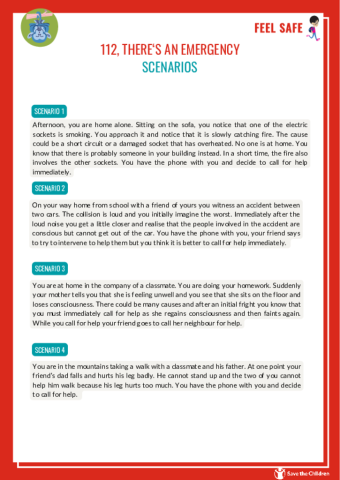112, there's an emergency
Objectives:
- Discover how to communicate an emergency
- Be more aware of and ready to react to an emergency
- Stimulate problem solving
STEP BY STEP
Before starting
The teacher shares some important information with the class on what to do in an emergency:
- The number 112 is the number you can call in an emergency
- Remain calm and answer the questions the operator will ask you by giving all the information requested e.g.:
Name and surname - Telephone number - Address - What happened - People involved
- Wait for help to arrive and follow the instructions of the telephone operator
- Leave the phone number you called from free
At this point the teacher asks the class: "When do you think you should call for help?"
Discussion on the topic is opened to understand what the perception of the emergency is, using the following questions:
- Have you ever called for help?
- Have you ever seen or heard someone call for help?
- Think of a situation in which you feel the need to call for help
It's showtime
The teacher distributes to the class four Emergency Scenarios (see attached "Calling for Help - Scenarios" below) in which help must be called.
The class is at this point divided into pairs. From the proposed scenarios, each pair chooses one and imagines a hypothetical call for help.
On one side will be the person who calls the emergency number and on the other side the person who answers. Once they are ready, they take turns staging the call to help in front of the rest of the class.
Any props can be used to play their part better (phone, computer, headphones, note sheet, etc.).
The rest of the class observes the scene prepared by each pair and notes on a sheet all the correct behaviors, communication errors made and small observations that seem relevant to them.
Emergency over?
When all pairs have experienced a scenario, the observations noted by the rest of the groups are shared, and the teacher then summarizes the correct and incorrect behaviors on a poster or on the interactive whiteboard.
At the end of the sharing time, the teacher will show the following video in which the behaviors and procedures to follow when calling for help are recapped:
112: Emergency call
Concluding thoughts
Everyone's behaviour is decisive when calling for help. It is essential to follow all the information given on the phone.
In the case of injured or sick people, here is what NOT to do while waiting for the ambulance to arrive:
- Panic
- Move the traumatised person
- Administer drugs
- Administer food or drink
Now everyone in the class knows how to call for help and the teacher can suggest that the students share what they've learned with their friends and family.

Add new comment